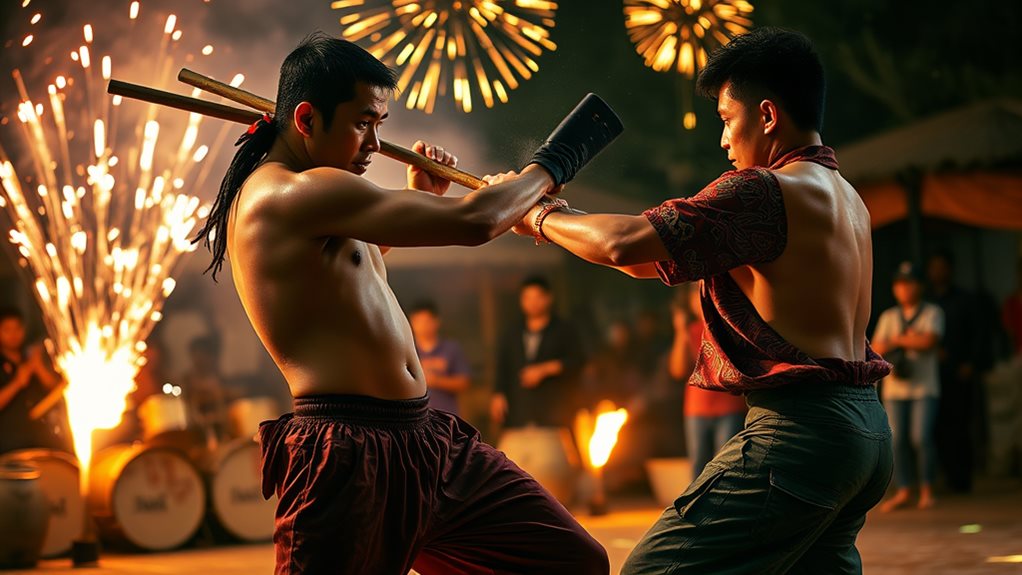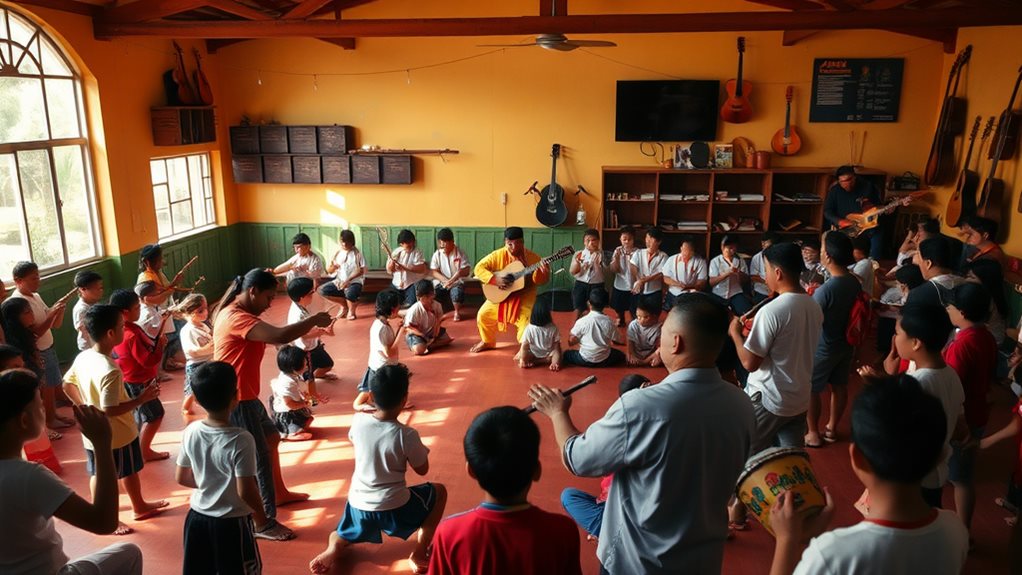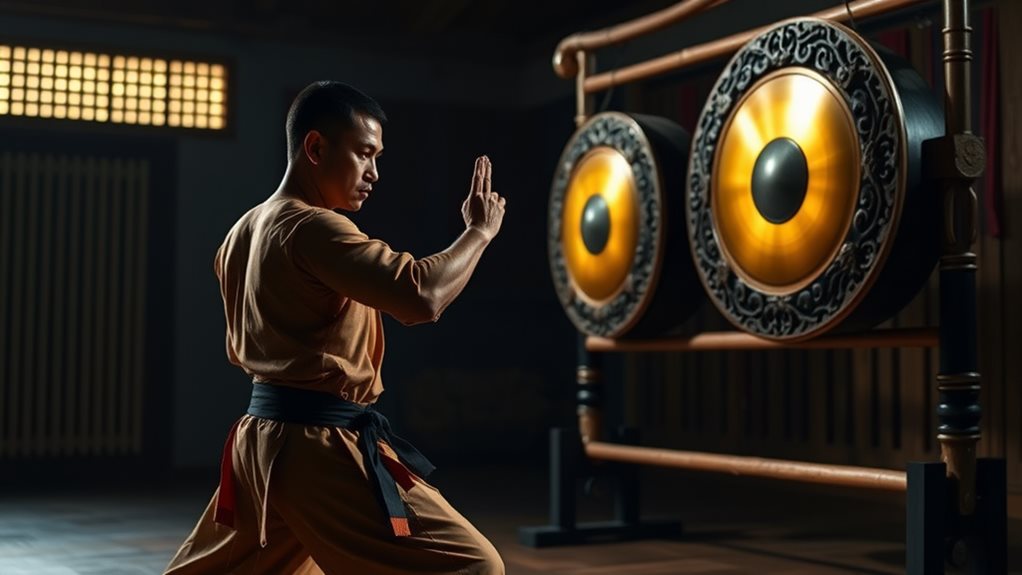You engage with traditional Kulintang rhythms to enhance timing and coordination in Filipino Martial Arts training, connecting your practice to rich cultural heritage and tribal traditions. Music historically guided movements and strategies, reinforcing Filipino identity. Live drumming simulates combat dynamics, sharpening your timing and coordination skills. Specific techniques benefit from rhythmic training, improving agility and flow. Drums and Kulintang align rhythms with combat techniques, fostering focus and community pride. Playlists with popular songs like “Oye Como Va” can boost engagement and motivation. Sparring to energetic beats enhances performance and enjoyment. Community discussions showcase the importance of music in FMA, blending martial arts with cultural expression. Engaging with these musical traditions deepens your understanding and appreciation of Filipino history and identity.
Historical Music Use
In the heart of Filipino Martial Arts training, traditional music plays a pivotal role, enhancing timing and rhythm. Integrate live drumming into your sessions to sharpen your coordination and reflexes.
Tribal rhythms and Kulintang music, in particular, strengthen your connection to ancestral roots. These sounds have historically guided movements and strategies, much like how music once accompanied martial demonstrations and practices.
By following these rhythms, you train your body to respond instinctively. Embrace these rhythmic elements to develop your timing, reaction skills, and overall performance.
Music in Filipino Martial Arts training isn’t just a background noise; it’s a tool that harnesses your full potential, drawing from the historical roots where martial arts were intertwined with cultural performance and storytelling.
Cultural Significance
Embracing the cultural tapestry of Filipino Martial Arts involves weaving music into your training for more than just rhythmic accompaniment; by integrating traditional Kulintang rhythms and other historical musical elements, you honor and deepen your connection to the rich heritage that shaped these combat techniques, fostering a sense of community and preserving cultural identity.
Exploring the blend of indigenous Filipino sounds with Spanish influences through kulintang music helps you understand the diverse historical factors that have contributed to FMA. This integration enhances your timing and coordination, mirroring movements in traditional dances, reinforcing the artistic and cultural dimensions of your practice.
Engaging with these musical traditions not only strengthens your bond with fellow practitioners but also acts as a modern day link to preserving Filipino cultural identity, ensuring that the soul and spirit of FMA endure through each training session.
Rhythm in Training

With rhythmic movements ingrained into your FMA training, you enhance your coordination and timing, mirroring the intricate steps of traditional dance, and thereby improving your overall effectiveness in Filipino Martial Arts. Timing is critical in martial arts, as Bruce Lee emphasized, and rhythmic training sharpens your ability to execute techniques precisely and counter opponents accurately. Incorporating live drumming into your FMA training sessions can significantly boost your timing skills and simulate the dynamic nature of combat. This method not only improves engagement but also aids in enhancing reaction times during sparring. Rhythmic training, akin to dance classes, contributes to a well-rounded understanding of movement, further refining your performance.
| Technique | Rhythmic Benefits |
|---|---|
| Stick Iridoan | Improved footwork, agility |
| Escrima footwork | Enhanced coordination, speed |
| Kali Live Sparring | Quick reaction, better flow |
Music Preferences
Building on rhythmic training, understanding your music preferences can take your Filipino Martial Arts training to the next level.
Start by exploring popular choices like “Oye Como Va” by Carlos Santana and “Petrified” by Fort Minor, whose energetic beats can enhance your sessions.
Don’t overlook “Bring the Pain” by Method Man and “Body Movin'” by Beastie Boys for their lively rhythms during practice.
Traditional Kulintang rhythms are also highly favored, honoring the cultural heritage of the Philippines.
Incorporating rhythmic music into training improves timing, coordination, and focus, crucial for martial arts mastery.
Adjust your playlist based on what keeps you most engaged and motivated, ensuring your music preferences support, not distract from, your practice goals.
Community Engagement

How does engaging with your community about training music enhance your Filipino Martial Arts practice? By participating in community engagement, you tap into a wealth of resources and insights that can elevate your training sessions.
Forums like MartialTalk host active discussions with over 870 views, showcasing community interest in music’s role. Sharing and listening to personal experiences and song recommendations fosters a collaborative environment, making training more effective and enjoyable.
Songs such as “Oye Como Va” by Carlos Santana and “Petrified” by Fort Minor are popular for their energetic beats, aiding focus and rhythm. Music in FMA training reflects cultural pride, underpinning the heritage of the martial art form.
Community engagement around music preferences illustrates interconnectedness among practitioners, reinforcing shared identity and enhancing collective learning. Dive into these conversations, and you’ll not only find inspiration but also integrate valuable feedback to refine your practice.
Timing Enhancement
A critical element in your Filipino martial arts (FMA) practice, timing is essential for executing techniques effectively by anticipating and responding to an opponent’s movements.
Utilize training music, such as traditional Kulintang rhythms, to enhance your timing skills by synchronizing your movements with a rhythmic environment.
Disrupting an opponent’s rhythm is integral to FMA, and rhythmic drills can improve your reaction times, enabling more effective counter techniques during sparring.
Engage in live drumming during practice sessions to simulate real combat scenarios, helping you develop a timing sense that’s crucial for success in both training and actual combat.
Practicing FMA with a focus on rhythmic elements can lead to improved coordination and timing.
Draw parallels with dance training to foster a deeper understanding of movement dynamics, ensuring your techniques aren’t just powerful but executed precisely at the right moment.
Cultural Expression

Harmony fuels your Filipino martial arts (FMA) training, connecting your movements to your cultural roots and enhancing the dynamic atmosphere of practice.
When you hear the beats of traditional Kulintang rhythms, you not only sharpen your timing but also forge a link to the ancient musical heritage of the Philippines. This music isn’t just background noise; it’s a vocal acknowledgment of your cultural identity and the history that shaped FMA.
To further this expression, consider visual symbols like the Philippine flag at your training venue, reminding you and your fellow practitioners of the country’s fight for freedom and unity.
Playing popular training songs like “Oye Como Va” and “Bring the Pain” also imbues your sessions with a sense of national pride and collective spirit, reinforcing the idea that FMA is more than just combat skill—it is a cultural expression.
Using Music in this way not only motivates but integrates a deeper understanding of Philippine culture into every strike and block, making your training an act of reverence and celebration of your heritage.
Traditional Influences
Traditional Filipino martial arts training often features live drumming to sharpen your timing and rhythm, reflecting the deep cultural ties between music and combat in the Philippines. This traditional practice enhances your coordination and reinforces the cultural identity of martial arts practitioners. The rhythmic movements you learn in FMA are influenced by traditional Filipino dance and music, emphasizing the interconnectedness of these cultural expressions. Tribal beats and rhythms are integrated into training sessions, fostering not only better combat skills but also a stronger cultural awareness. Historical ties between music and martial arts are evident in community demonstrations, where performances combine martial techniques with musical elements to educate and entertain audiences. Here’s an overview of traditional influences:
| Aspect of Training | Traditional Influence |
|---|---|
| Live drumming | Sharpen timing and rhythm |
| Rhythmic movements | Influenced by Filipino dance and music |
| Kulintang (gong ensemble) | Provides unique musical backdrop during FMA |
| Community demonstrations | Combine martial techniques with musical elements |
| Tribal beats and rhythms | Aid coordination, timing, and cultural identity |
Musical Instruments

Why might you find yourself moving to the steady beat of drums during Filipino martial arts training? The purpose of incorporating musical instruments like drums extends beyond mere accompaniment. Engaging with these rhythmic sounds enhances your timing skills and simulates real combat scenarios, making your movements more fluid and precise.
The kulintang, known for its intricate gong patterns, plays a pivotal role in this process by aligning specific rhythms with combat techniques.
- Refines your coordination, similar to dance training
- Connects you to cultural heritage through traditional instruments
- Improves focus and engagement during practice sessions
How Has Music in Filipino Martial Arts Influenced Filipino Musical Theater?
The fusion of music in Filipino Martial Arts has significantly shaped the history of filipino musical theater. Traditional rhythms and melodies from martial practices infuse dramatic storytelling, enhancing emotional depth and cultural resonance. This unique blend enriches performances, creating a vibrant connection between the martial arts and theatrical expressions in Filipino culture.
Personal Experiences
As you step into the dojo, the rhythmic beat of the kulintang fills the air, guiding your movements with a sense of purpose and cultural heritage.
In Los Angeles, finding a martial arts school that integrates music into training sessions can transform your practice. Every strike and block responds to the kulintang’s melody, sharpening your timing skills.
You might also start sparring to the driving beats of “Oye Como Va” by Carlos Santana or the powerful rhythms of “Petrified” by Fort Minor, pushing yourself to perform at your peak.
Live drumming sessions in Los Angeles engage your senses, simulating real combat scenarios and enhancing your focus.
This approach, deeply rooted in Filipino culture, makes training not just a physical activity but an immersive journey into the soul of the art.
Engaging with music during your training in Los Angeles not only refines your martial abilities but also reinforces the cultural tapestry of Filipino martial arts.
Questions and Answers
What Is the Mixture of Martial Arts Dance and Music?
You blend martial arts dance with music by focusing on rhythmic flow, syncing choreographed movements to musical beats, enhancing coordination, timing, and cultural engagement in training.
What Is the Origin of Filipino Martial Arts?
Explore your cultural heritage by tracing Filipino martial arts origins back to resistance against Spanish occupation, blended with influences from Majapahit, Sri Vijayan, and Indian warriors, shaping diverse yet fluid techniques.
Why Is Filipino Martial Arts Considered a Complete Fighting Art?
Understand why Filipino Martial Arts is considered a complete fighting art by integrating Cultural Heritage through its diverse weapon techniques, emphasizing counter-for-counter methods, and offering a unique skill set across over 200 styles.
What Do Filipino Martial Arts Teach?
Filipino martial arts teach a blend of weapon-based and empty-hand techniques, emphasizing safety, fluidity, speed, strategic positioning. Incorporating cultural expression, you’ll master over 200 styles ensuring practical self-defense proficiency.